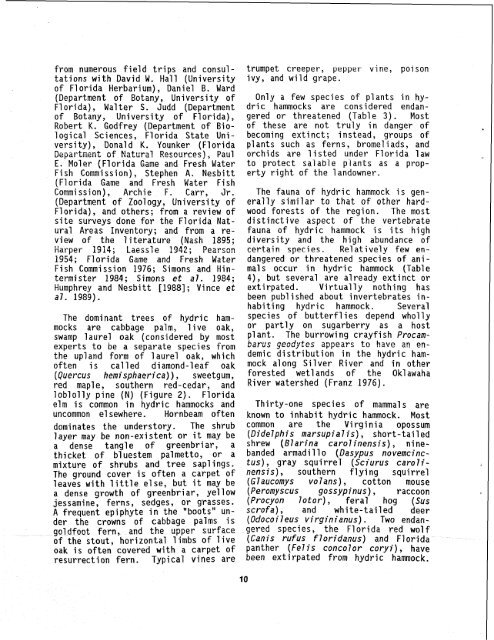a Guide to Management - USGS National Wetlands Research Center
a Guide to Management - USGS National Wetlands Research Center
a Guide to Management - USGS National Wetlands Research Center
You also want an ePaper? Increase the reach of your titles
YUMPU automatically turns print PDFs into web optimized ePapers that Google loves.
from numerous field trips and consul-<br />
tations with David W. Hall (University<br />
of Florida Herbarium), Daniel B. Ward<br />
(Department of Botany, University of<br />
Fl ori da) , Walter S. Judd (Department<br />
of Botany, University of Florida),<br />
Robert K. Godfrey (Department of Bio-<br />
1 ogi cal Sciences, Florida State Uni -<br />
versi ty), Donald K. Younker (Florida<br />
Department of Natural Resources), Paul<br />
E. Moler (Florida Game and Fresh Water<br />
Fish Commission), Stephen A. Nesbitt<br />
(Florida Game and Fresh Water Fish<br />
Commission), Archie F. Carr, Jr.<br />
(Department of Zoo1 ogy, University of<br />
Florida), and others; from a review of<br />
site surveys done for the Florida Nat-<br />
ural Areas Inven<strong>to</strong>ry; and from a re-<br />
view of the 1 iterature (Nash 1895;<br />
Harper 1914; Laessle 1942; Pearson<br />
1954; Florida Game and Fresh Water<br />
Fish Commission 1976; Simons and Hin-<br />
termister 1984; Simons et a7. 1984;<br />
Humphrey and Nesbitt [1988]; Vince et<br />
a7. 1989).<br />
The dominant trees of hydric ham-<br />
mocks are cabbage palm, live oak,<br />
swamp laurel oak (considered by most<br />
experts <strong>to</strong> be a separate species from<br />
the upland form of laurel oak, which<br />
often is called diamond-leaf oak<br />
(Quercus hemisphaerica) ) , sweetgum,<br />
red maple, southern red-cedar, and<br />
loblolly pine (N) (Figure 2). Florida<br />
elm is common in hydric hammocks and<br />
uncommon el sewhere. Hornbeam often<br />
dominates the unders<strong>to</strong>ry. The shrub<br />
layer may be non-existent or it may be<br />
a dense tangle of greenbriar, a<br />
thicket of bluestem palmet<strong>to</strong>, or a<br />
mixture of shrubs and tree saplings.<br />
The ground cover is often a carpet of<br />
leaves with little else, but it may be<br />
a dense growth of greenbriar, yellow<br />
jessamine, ferns, sedges, or grasses.<br />
A frequent epiphyte in the "boots" un-<br />
der the crowns of cabbage palms is<br />
goldfoot fern, and the upper surface<br />
of the s<strong>to</strong>ut, horizontal 1 imbs of 1 ive<br />
oak is often covered with a carpet of<br />
resurrection fern. Typical vines are<br />
trumpet creeper, pepper. vine, poi son<br />
ivy, and wild grape.<br />
Only a few species of plants in hy-<br />
dri c hammocks are considered endan-<br />
gered or threatened (Table 3). Most<br />
of these are not truly in danger of<br />
becoming extinct; instead, groups of<br />
plants such as ferns, bromel iads, and<br />
orchids are 1 i sted under Florida 1 aw<br />
<strong>to</strong> protect salable piants as a prop-<br />
erty right of the landowner.<br />
The fauna of hydric hammock is gen-<br />
erally similar <strong>to</strong> that of other hard-<br />
wood forests of the region. The most<br />
distinctive aspect of the vertebrate<br />
fauna of hydric hammock is its high<br />
diversity and the high abundance of<br />
certain species. Re1 atively few en-<br />
dangered or threatened species of ani-<br />
mal s occur in hydri c hammock (Tab1 e<br />
4), but several are already extinct or<br />
extirpated. Virtually nothing has<br />
been pub1 i shed about invertebrates in-<br />
habi ting hydric hammock. Several<br />
species of butterflies depend wholly<br />
or partly on sugarberry as a host<br />
pl ant. The burrowing crayfish Procam-<br />
barus geodytes appears <strong>to</strong> have an en-<br />
demic distribution in the hydric ham-<br />
mock along Silver River and in other<br />
forested wetlands of the Oklawaha<br />
River watershed (Franz 1976).<br />
Thirty-one species of mammals are<br />
known <strong>to</strong> inhabit hydric hammock. Most<br />
common are the Virginia opossum<br />
(Didelphis marsupialis), short-tailed<br />
shrew (B7arina carolinensis), nine-<br />
banded armadi 11 o (Dasypus novemcinc-<br />
tus) , gray squirrel (Sciurus caro7i-<br />
nensis) , southern flyi ng squirrel<br />
(G7aucomys volans) , cot<strong>to</strong>n mouse<br />
(Peromyscus gossypinus) , raccoon<br />
(Procyon lo<strong>to</strong>r), feral hog (Sus<br />
scrofa) , and whi te-tail ed deer<br />
(Odocoi7eus virginianus). Two endan-<br />
gered species, the Florida red wolf<br />
(Canis rufus floridanus) and Florida<br />
panther (Felis concolor coryi), have<br />
been extirpated from hydric hammock.

















